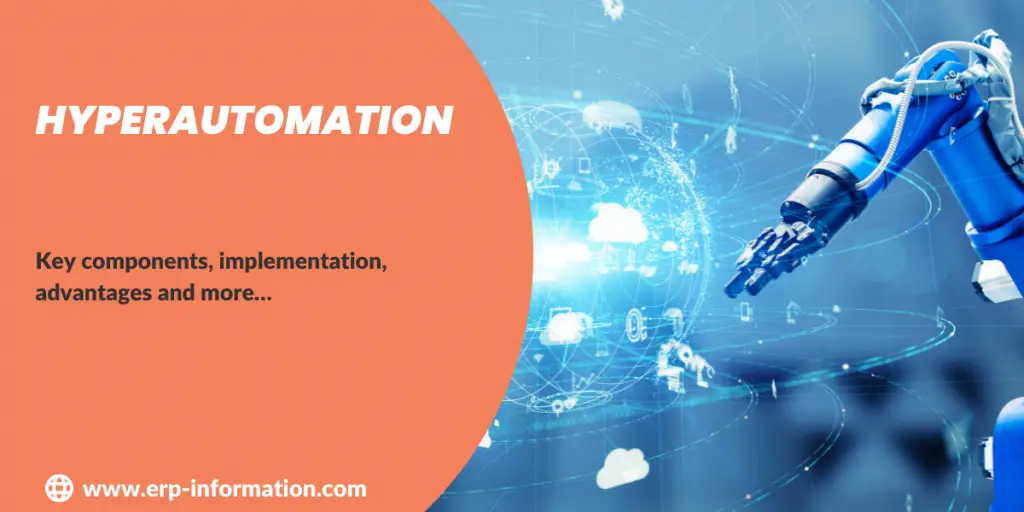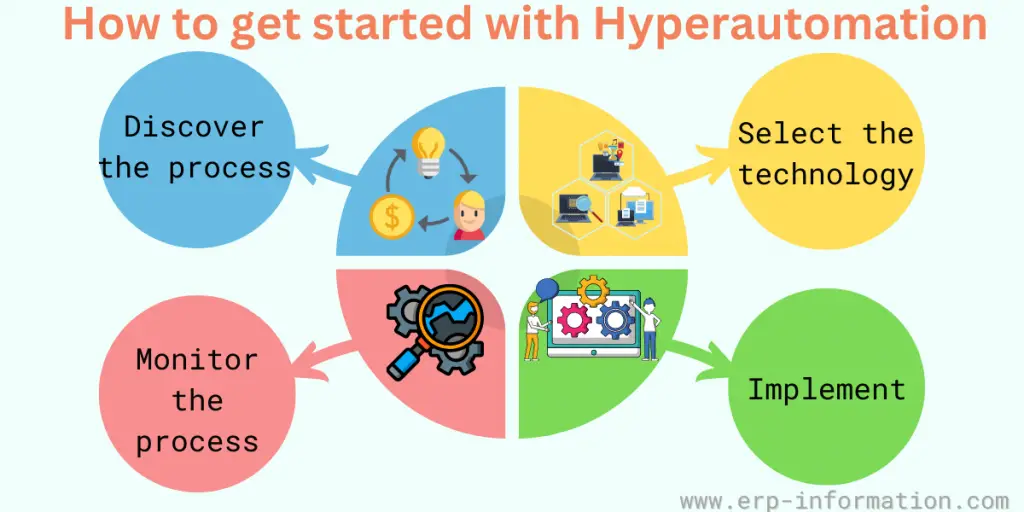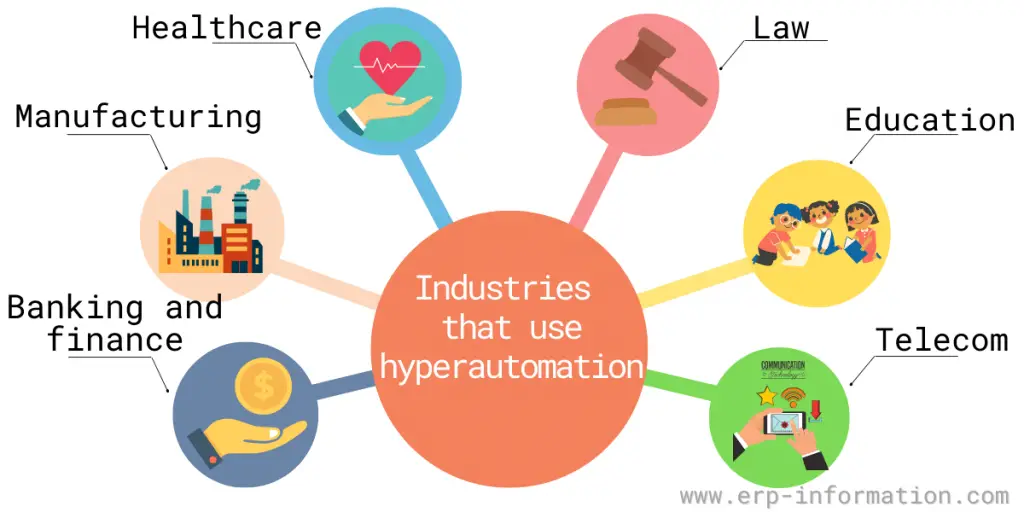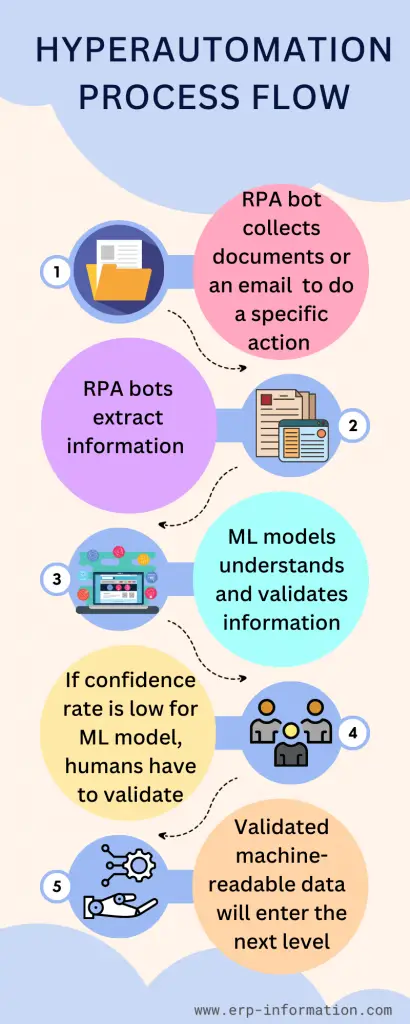Hyperautomation is the next step beyond automation. It uses advanced technologies, such as artificial intelligence (AI) and machine learning (ML), to automate tasks.
This blog post will look at what Hyperautomation is, its key components, how to get started with it, and its advantages, disadvantages, and challenges while implementing it.
What is Hyperautomation?
Hyperautomation corresponds to advanced technologies to automate business processes and tasks that humans have traditionally performed. Automating these business processes can help organizations improve efficiency, speed up processes, and free up employees to focus on more strategic technology trends.
It is sometimes referred to as “Robotic Process Automation (RPA) on steroids“ because it takes RPA to the next level by using AI and machine learning to automate more complex tasks. For example,
This can automatically generate reports or analyses based on data from multiple sources, which would be difficult or impossible for a human to perform.
Key components
Hyperautomation is the use of automated technology to streamline and improve workflows. Its technologies include robotic process automation, artificial intelligence, and machine learning.
RPA
RPA is a software program that automates repetitive, rules-based human tasks. For example, you can program an RPA software bot to fill out standard forms or extract data from a CRM system and populate it into a spreadsheet.
AI
AI refers to the ability of machines to learn and work smarter. You can use AI for pattern recognition, natural language processing (NLP), and decision-making. Examples include digital assistants like Siri and Alexa.
ML
ML is a subset of AI that refers to the ability of machines to learn from data. ML involves using algorithms to train software to improve its performance over time. For example, a machine learning algorithm can automatically flag potential errors in data entry. As a result, decision-makers can use it for predictions, recommendations, and classification tasks.
How can businesses get started with Hyperautomation?
Discover the process
The first step is to discover which process can be automated. That can be done by looking at current manual and time-consuming strategies or by examining new approaches that could be created with the help of automation.
Select the right technology
Once the decision has been made to automate a task, the next step is to select the right technology for the job. There are a variety of automation technologies available.
Implementation
After the technology has been selected, it is essential to test and implement it to minimize disruptions to business operations.
Monitor process
Finally, once the automation technology is up and running, it is vital to monitor its performance and make adjustments as necessary.
Where is Hyperautomation can be used?
Companies can use it in several sectors; some of them include,
Banking and finance
These sectors operate where there are much data to deal with. Hyperautomation reduces the complexity by automating customer service tasks such as account opening and loan processing. In finance, it automates stock market analysis, financial report generation, and more.
Manufacturing
In the manufacturing sector, it enables automation of machine monitoring, quality control, assembly line tasks, order fulfillment, and inventory management.
Healthcare
It also helps in the medical field by automating processing such as patient data entry, insurance claims, accumulating data, and giving beneficial output for more effective remedy plans.
Law
In legal processing, it automates the drafting of legal documents using natural language processing and also automates contract review and case management.
Education
Automating student admissions and grade tracking by using RPA bots
Telecom
Automating network repair and customer service tasks.
Hyperautomation process flow
Here we will explain the process triggered by incoming emails or documents. The process is as follows.
- RPA bot collects incoming documents or emails that may contain semi-structured or unstructured data.
- The ML model helps to process these documents or emails by extracting machine-readable data from emails or documents.
- After that, ML models validate machine-readable data. It ensures that there is no fraud.
- Database or ML models enrich validated data. For example, a customer’s ID can be compared and validated with the organization’s customer master data.
- If you are confident with the ML model, there is no need to review the output by human beings. If confidence is less, then human beings must review the output with the help of human-in-the-loop software.
- At last, enriched and validated machine-readable data will enter the next system.
One more type of process is a fully automated/digital process.
In this process, the client or organization’s internal process provides structured data (already well-organized and formatted data), and the process gets activated by this data. These automated tasks can be quickly implemented.
Using hyperautomation, businesses can experience immense advantages in common sectors such as finance, sales, marketing, and customer service.
Advantages and Disadvantages of Hyperautomation
Advantages
There are many benefits of hyperautomation, including:
- Increased efficiency: Intelligent process automation can help businesses streamline their workflows and improve efficiency.
- Improved accuracy: Automating tasks can help to reduce the risk of human error and improve accuracy.
- Increased productivity: Freeing employees from repetitive tasks can lead to increased productivity.
- Improved agility: Digital process automation in businesses can help quickly respond to market or customer demand changes.
- Cost savings: Automating tasks can help businesses save on labor costs.
Disadvantages
There are also some potential disadvantages of hyper-automation. They are
- Job loss: As more tasks are automated, job loss is at risk as machines replace employees.
- Dependence on technology: As businesses become reliant on technology for more tasks, they may be less able to function if there is a technical malfunction.
- Automation efforts: There is a risk that businesses may not see a return on their investment if they do not adequately plan and execute their hyperautomation efforts.
Challenges
There are several challenges that businesses may face when implementing hyperautomation, including:
- Implementing hyperautomation can require businesses to change their organizational structure and culture.
- Getting sophisticated analytics tools
- To find a return on your investment
- Choosing the appropriate hyper-automation infrastructure
- The lack of existing business process knowledge might make implementation difficult and time-consuming.
The future of Hyperautomation
The future of hyperautomation is challenging to predict, as it will largely depend on the advancement of technology. However, it will likely continue to grow as businesses look for ways to improve efficiency and speed up processes.
Additionally, as AI and ML become more advanced, businesses will increasingly use these technologies in hyper-automation.
Top 7 Hyperautomation tools
Top 7 Hyperautomation tools to scale automation in the organization include,
- ProcessRobot
- UiPath
- Blue Prism
- Automation Anywhere
- WorkFusion
- Kofax
- PegaSysople
FAQs
What are the top 10 Strategic Technologies?
1. Artificial intelligence (AI)
2. Machine learning (ML)
3. Robotic process automation (RPA)
4. Internet of Things (IoT)
5. Big data 6. Blockchain
7. Cloud computing
8. Cybersecurity
9. Virtual reality (VR)
10. Augmented reality (AR)
What is the difference between Automation and Hyperautomation?
The main difference between automation and hyperautomation is that automation can automate simple tasks, while hyperautomation is used to automate complex tasks.
What is UiPath?
UiPath offers desktop and web automation capabilities that make it easy to automate repetitive tasks. It can help you streamline your business processes and improve the efficiency of data entry and report generation. In addition, UiPath’s drag-and-drop interface makes it easy to create automation flows, even if you don’t have any coding experience.
Who introduced Hyperautomation?
Gartner introduced the term Hyperautomation in 2019.
Conclusion
Hyperautomation is using technology to automate as many tasks as possible to improve efficiency. That can include automating manual tasks or decision-making processes.
The technique will continue to grow in popularity as businesses look for ways to improve efficiency and speed up processes.



